A reluctant winter clung to an early March morning while flakes of snow silently fell on eight fully suited divers as our open-skiff slowly motored across glassy-calm water to the first dive site. No one spoke a word.
Contributed by
I couldn’t help but notice the beauty of nature all around. Even through a light veil of surface fog, dark evergreens towered atop rocky shorelines of nearby islands, now bathed in the soft hues of dawn. Perched high above us in a tree, an eagle squawked with another as we passed, followed by the quiet gurgle of an otter entering the water.
“Five minutes out!” announced our dive guide, John de Boeck, owner of Browning Pass Hideaway on northern Vancouver Island. “Below rests the skeleton of the SS Themis wreck. Watch your depth and especially watch your bottom time because the currents really move around Croker Rock. While diving here, it’s possible you might see the ship’s bathtub, maybe the boilers, a few octos and watch out for immense wolf-eels!”
I rubbed my cold hands together and blew some warm air on them before donning drygloves and attaching them to my drysuit. As we prepared to enter the chilly water, John added the general site details and said, “Don’t worry, by now the wolf-eels have already eaten their breakfast…” Yes, I’ve grown accustom to John’s wit over the years. For someone who has been offering dive excursions since 1981, he knows the area eerily well.
Slipping beneath the surface through a forest of tall gently swaying kelp fronds proved to be as magnificent as the topside terrain. Life and color was everywhere. Black rockfish hovered mid-water, not in the least bit afraid of us. I am sure if the light was brighter, the ship’s remains would have been in full view 60ft (18m) below—the visibility was that good.
My husband, Wayne, wasted no time in locating his first wolf-eel. A few needle white teeth oddly protruded through huge rubbery lips. Muppets always come to mind when I see these comical characters up close. All around its den were piles of crumbled scallop, urchin and crab shells. This guy indeed had an appetite for seafood, a lot like Wayne…
After the wolf-eel had ventured out to greet several of us, we continued to circumnavigate the hull, finding a different assortment of critters living on every protruding piece of wreckage. Puget Sound king crabs, clusters of gray colored sponge, anemones, pink and red soft corals and multitudes of small fish adorned our path at every turn. It was clear from the amount of life, the cold nutrient-rich water circulating through this area was supporting a vibrant ecosystem, similar to other dive locations in BC.
One of my favorite scenes to photograph on the wreck was old fishing nets hanging and draped over the stern of the vessel. They had been there for so long and were so heavy with collected invertebrate life, they no longer moved much in the current.
Retreating to a more sheltered part of the wreck, we encountered two sets of coal-black eyeballs suddenly peering out at us. Was it another wolf-eel, no… Then two huge brown masses darted by us from behind. Whoa! Turned out the two sets of eyes belonged to two small harbor seals, which were hiding from two very large sea lions. John later explained the sea lions like to harass harbor seals as a form of play. Makes me wonder if the orcas like to play with the sea lions too? Overall, this enchanting site was as fun to explore as it was to photograph.
For visiting divers
One of the things I like best about diving in the Pacific Northwest is the diversity of shipwrecks British Columbia has to offer. There are plenty of natural wrecks all over coastal BC and sites purposely created by the placement of retired military ships to attract divers. Most are easily accessible and host an assortment of marine residents.
The Artificial Reef Society of British Columbia (ARSBC—www.artificialreef.bc.ca), a not-for-profit group, has scuttled eight over the past 25 years. Although most exceed 300ft (91m) in length, all are within reasonable depths to suit any level of diving skill, including technical divers.
To facilitate diving in this unique region for potential visiting divers, I have compiled a list of some of the more colorful and interesting wrecks. Working in a circular direction, we will start at the southern end of Vancouver Island, traveling north up the island and across to the Sunshine Coast, then back to Mainland Vancouver along the coast.
Vancouver Island
G.B. Church. Near the town of Sidney, and within minutes from Victoria (BC’s capital city), the G.B. Church sits upright in 50 to 90ft (15 to 27m) of water off Portland Island in Princess Margaret Marine Park. At 175ft (53m) in length, this freighter was the first ARSBC project with a successful sinking in 1991. Over the years, marine life wasted no time in occupying the ship’s deck, hull and structures, which are now thick with encrusting tubeworms, nudibranchs, anemones and other invertebrate life. Small fish thrive around the wreck, often using it like a nursery.
“I like diving on the ARSBC’s wrecks to learn about local history,” commented visiting diver Degan Walters from Seattle, Washington. “And it’s a way to do something I love. But I still like to see and photograph underwater life, so although I’m wreck certified, I don’t spend a lot of time deep inside the wrecks.
“One of my favorite experiences was when my dad and I dove the G.B. Church, which was my first time diving a wreck and my first time diving with my dad! We entered the bridge and it was entirely covered with plumose anemones. I also saw an octopus in its den and lingcod everywhere.”
HMCS Mackenzie. The retired HMCS Mackenzie was scuttled in 1995 off Gooch Island in 100ft (30m) of water. Divers can reach the wreck as shallow as 30ft (9m) or venture into one of the many large access holes cut into the vessel’s hull and decks (as with all the ARSBC projects). Special note: The Mackenzie was used in an episode of the television series, The X-Files, too!
Rockfish Divers, a new dive shop and charter operator in Victoria, has some great dive videos (courtesy of Alisa Preston) and images of both wrecks posted on their website. During a recent charter, Alisa created some interview questions for one of the passengers, Travis Kintzinger, a divemaster in training, about his local dive experience. Here is an excerpt:
AP: What were your first impressions of the artificial reefs off Sidney, BC?
TK: They were lovely, great dives. The visibility was excellent—upwards of 40ft (12m). The magnitude of the wrecks was impressive, making you feel way smaller in comparison.
AP: What kind of life did you see on the wrecks?
TK: On both, there was tons of life, yet each seemed to have something a little different too—more brittle stars on the McKenzie, more Puget Sound king crabs on the Church. There was a huge density of plumose anemones, but also lingcod, cabezon, decorator crabs and more invertebrate life than you can list.
AP: What stood out for you on the McKenzie?
TK: How well the structure of the ship is preserved. Other than it being covered in aquatic life, it was easy to see all the features of the ship, including the opportunity to peek inside and see the rooms. There was a desk with a chair still sitting in front of it.
AP: What about the G.B. Church?
TK: There was a huge giant Pacific octopus that was very visible under the bow of the ship. The midden heap clearly showed that this creature was quite comfortably settled in. Because this ship is a little smaller, it was much easier to circumnavigate the entire ship and explore the plumose-covered upper part of the structure as well.
Rockfish Divers operate two dive boats to these wrecks and other sites in the local area throughout the year.
Xihuw Boeing 737. The Boeing 737-200 airframe was scuttled in 2006 not far from the community of Chemainus in 60 to 100ft (18 to 30m) of water. Dubbed the Xihuw Reef (xihuw meaning red sea urchin, pronounced key’ quot) by local Hul’qumi’num First Nations, the indigenous people of the area, the plane sits on support stands to keep it off the bottom.
According to local B&B owner, zoologist and book author Andy Lamb, the plane now hosts a large population of feather stars on the supports. “Species come and go in cycles like the pale creeping pedal sea cucumber, Psolidium bidiscum. As a non-wreckie more interested in critters, I enjoy the plane because it is easy to dive and penetration is safe, but it also has lots of creatures hiding in its many crannies.”
“Not much more to add,” said charter operator, Peter Luckham from 49th Parallel Diving, who takes four divers out at a time. “It continues to be a very cool dive with lots of critters—117 recorded species on the plane as of July 2015, which are species that Andy or I have confirmed seeing.”
Peter advises making advanced booking for the diving, as with BC Ferries.
HMCS Saskatchewan and Cape Breton. Located off Snake Island near Nanaimo, a destination hub for BC Ferries, both wrecks sit upright, occasionally experiencing a slight current, which feeds the abundance of life now residing on both wrecks.
The 366ft (112m)-long Saskatchewan was scuttled in 1997 and rests in about 130ft (~40m) with the radar platform reached at 40ft (12m). The Cape Breton (about 400ft or 122m) was placed not far from the Saskatchewan in 140ft (43m) of water in 2001. As with the other ARSBC projects, both wrecks are riddled with large diver access holes throughout.
“All wrecks here have been very popular,” said Ed Singer, charter operator and owner of Sundown Diving in Nanaimo. “They are used on a regular basis for training by Coast Guard RCMP and a variety of recreational and technical divers.
“We have been seeing an abundance of cabezon fish on the bigger wrecks lately, and the cloud sponges have been doing very well. We had a group from Denmark out on the September long weekend, and on the way to the wrecks, we were lucky to see humpback whales, which we have been seeing a bit more in this area all summer. The seals are still covering Snake Island and do venture out to visit us on the wrecks. Visibility is starting to pick up for the winter season, ranging from 50 to 90ft (15 to 27m)! Our new vessel as of May has been keeping very busy, departing from Nauticals Marina, which is a 15 to 20-minute ride to the wrecks and five minutes to the Rivtow Lion.”
Vanlene. I mention this natural 473ft (144m)-long wreck, which sank off Austin Island in Barkley Sound in 1972 on the west side of Vancouver Island, because it is like diving two different sites in one location. The bow portion of the broken freighter is scattered about at the top of a reef in 25 to 50ft (~8 to 15m) of water while the remainder of its twisted hull stretches down a steep rocky reef to over 100ft (30m) in depth.
Both sections are home to adult and juvenile rockfish, perch and lingcod as well as a healthy population of anemones and sea stars, but I have always found quite a colorful variety of nudibranchs in the shallower section. We have also been visited by curious harbor seals who like to hang around the divers. The deeper sections, however, allow for superb imagery and video possibilities with large mangled sections, ghostly tires from its original cargo of Dodge Colts, and odd-looking ratfish to photograph.
This is just one of many cool wrecks in Barkley Sound. Most have been recorded and explored by the Underwater Archeology Society of BC and can be found on their website: www.uasbc.com.
HMCS Columbia and SS Capilano.
Scuttled in 1996 next to Maude Island between Campbell River and Quadra Island, the Columbia sits upright in 120ft (~37m) of water, just around the corner from Seymour Narrows, another great dive site. Worthy of a look is the accordion-shaped bow, caused by the impact during sinking with hard unforgiving bedrock. Another point of interest is the six huge rear gun barrels, often filled with tiny juvenile rockfish.
Earl Lowe, owner of Abyssal Dive Charters reports, “Well, we usually see lingcod and some fairly large cabezon or octopus. It’s been interesting watching the life change over the years from basically bare metal to being covered by swimming scallops, vase sponges, plumose anemones and huge feather-duster worms.”
When visiting the Columbia, I always try to drop over the side of the ship and check out the hiding spaces under sections of the hull where giant Pacific octopi often reside. On one dive there, Wayne and I found three!
The natural wreck of the 120ft (~37m) Capilano is located in the center of the Strait of Georgia, south of Mitlenatch Island sitting upright in 100 to 120ft (30 to 37m) of water. Charter operator and co-owner of Pacific Pro Dive, Bill Coltart, said with enthusiasm: “We are very excited! October marks the 100th anniversary of the sinking of the Capilano. She is still intact and covered with a plethora of marine life including huge boot sponges, cloud sponges, giant yelloweye rockfish, in addition to hundreds of copper rockfish and lingcod. The prop is completely covered in plumose anemones and is difficult to discern it as a propeller. “One of my best experiences there was being surrounded by dozens of dog sharks while completing a safety stop during an ascent after the dive!”
Pacific Pro Dive specializes in dive charters for technical and mixed-gas divers, offering a selection of deep wrecks and walls to examine. Bill himself is a Technical Diving Instructor Trainer for IANTD, PADI and TDI.
SS Themis. Located near Croker Rock in Queen Charlotte Strait, not far from Port Hardy at the northern end of Vancouver Island, this 270ft (82m)-long Norwegian cargo ship went down in 1906. Although it is pretty beaten up from years of exposure, many parts are still identifiable. You can often find resident wolf-eels, large Puget Sound king crabs and several species of sponges. Pink and red soft corals cover most of the structures making this an extremely colorful and photogenic site. You can still see the firebox, boiler and bathtub in the 50 to 70ft (15 to 21m) range as well as old fishing nets mentioned earlier, also covered with invertebrate critters.
Sunshine Coast
HMCS Chaudiere. Located in Sechelt Inlet off Kunechin Point, this was the first 366ft (111.6m) Destroyer Escort to be scuttled by the ARSBC in 1992. It lies on its port side in 50 to 140ft (15 to 43m) of water, festooned in a cloak of glass tunicates and anemones that line the railings and cover most of the topside structures. The two forward gun barrels point straight down with a growing cluster of cloud sponge near the bottom.
“The Chaud is an amazing wreck,” said Jon Dewsbury, who operates a rental cottage in Sechelt on the Sunshine Coast of BC, the Scuba Shack. “The starboard side of the destroyer is a great platform, which starts at around 50ft (15m) and gradually gets deeper to around 130ft (~40m). Over the years, life has made the Chaud its home, including lingcod, perch, the occasional octopus and wolf-eels. It’s a fun ship to explore.”
As a photographer, I have always enjoyed the emerald green color of the water to outline my shots while diving on the wreck. During winter months, the visibility is incredible, allowing a clear outline of the dive boats on the surface while you are on the wreck below.
Mainland Vancouver
HMCS Annapolis. Located in Halkett Bay off Gambier Island in Howe Sound, this was the ARSBC’s latest completed project with the sinking taking place in April of 2015. The vessel sits upright in 110ft (33.5m) of water, offering divers several additional features different from the other retired military ships. A helicopter hanger is completely open and ready to explore, along with covered walkways on either side of the vessel.
Local NAUI dive instructor and co-owner of Sea Dragon Charters, Jan Breckman said: “What makes the Annapolis so special is that it is shallower than most of the other artificial reefs. There is also plenty of ship to explore if regular divers want to keep in the 60ft (18m) depth range, and even starting at 45ft (13m). There are also way more diver access holes than most artificial reefs!”
It takes about 25 minutes to get to the site from Horseshoe Bay in Mainland Vancouver. As with all of the artificial reefs in BC, life has already begun to claim residence on this new reef of steel. It is just a matter of time before it, too, will be covered in a swathe of life.
Passport logbook
The Dive Industry Association of British Columbia has come out with a new free Wreck Trek diving passport and logbook (at www.diveindustryassociation.com/bc-wreck-trek) to aid visiting divers in their desire to explore the wrecks of coastal BC. For detailed information on the ARSBC artificial reefs, visit: www.artificialreef.bc.ca. For BC Ferry information and reservations (recommended during summer months), visit: www.bcferries.com.
Additional features
As mentioned earlier, this is just a handful of the wreck diving sites you will find along the waters of coastal British Columbia. In addition to these locations, be sure to check out the fabulous reefs, walls and underwater structures like a bronze mermaid in Powell River and over a dozen immense reef-balls in Victoria.
When not diving, there are plenty of activities to indulge in like hiking, zip-lining, skiing (winter), fishing and sight-seeing, not to mention excellent wineries and an array of local specialty cuisine establishments. ■































































